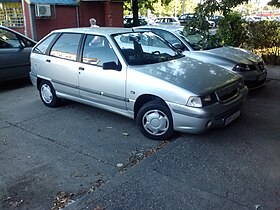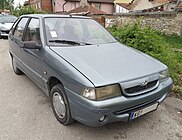
The Fiat 128 is a transverse front-engine, front wheel drive small family car manufactured and marketed by Fiat from 1969 to 1985 as a two- or four-door sedan, three- or five-door station wagon as well as two- or three-door coupé. The 128 running gear and engine, reconfigured for a mid-engined layout, were used in the Fiat X1/9 sports car.

The Fiat Uno is a supermini manufactured and marketed by Fiat. Launched in 1983, the Uno was produced over a single generation in three and five-door hatchback body styles until 1995 in Europe — and until 1 January 2014, in Brazil. Designed by Giorgetto Giugiaro of Italdesign, the Uno strongly recalled the high-roof, up-right packaging of Giugiaro's 1978 Lancia Megagamma concept, in a smaller configuration.

The Fiat Tipo is a compact car, designed by the I.DE.A Institute design house, and produced by the Italian manufacturer Fiat between 1988 and 1995.

The Rover 200 Series, and later the Rover 25, are a series of small family cars that were produced by British manufacturer Rover from 1984 until 2005.

The Fiat Punto is a supermini car (B-segment) produced by the Italian manufacturer Fiat from 1993 to 2018, spanning over three generations. The third generation of the car was marketed between 2005 and 2009 as the Grande Punto, and between 2009 and 2012 as the Punto Evo, until the single-word Punto name was reintroduced. As of May 2013, nearly nine million units had been sold globally.

The Rover 400 Series, and later the Rover 45, are a series of small family cars that were produced by the British manufacturer Rover from 1990 to 2005. The cars were co-developed as part of Rover's collaboration with Honda. The first-generation 400 was based on the Honda Concerto, and the Mark II 400 was based on the Honda Domani/Civic.
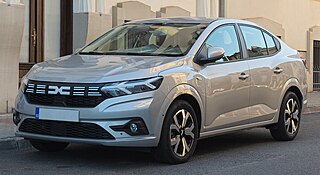
The Dacia Logan is a family of automobiles produced and marketed jointly by the French manufacturer Renault and its Romanian subsidiary Dacia since mid-2004, and was the successor to the Dacia 1310 and Dacia Solenza. It has been produced as a sedan, station wagon, and as a pick-up. It has been manufactured at Dacia's automobile plant in Mioveni, Romania, and at Renault plants in Morocco, Brazil, Argentina, Turkey, Russia, Colombia, Iran and India. The pick-up has also been produced at Nissan's plant in Rosslyn, South Africa.

The Renault 20(R20) and Renault 30(R30) are two executive cars produced by the French automaker Renault between 1975 and 1984. The most upmarket and expensive Renaults of their time, the two cars were almost identical with regard to sheet metal and mechanicals; the R30 was the larger-engined and more expensive of the two. The two cars were easily distinguished between each other from their differing headlight configuration – the Renault 20 had two single rectangular headlights, whereas the Renault 30 had quadruple round headlights. The interior specifications differed substantially, however, with the Renault 30 having a higher specification in all models. Over 622,000 R20s and 145,000 R30s were produced in Sandouville near Le Havre, France.

The Peugeot 207 is a supermini car (B) that was designed and produced by the French automaker Peugeot from 2006 to 2014. It was presented at the Geneva Motor Show in 2006, and entered production in April 2006, as the successor to the Peugeot 206. It shares the same platform with the Citroën C3.

The automotive industry in Italy is a quite large employer in the country, it had over 2,131 firms and employed almost 250,000 people in 2006. Italy's automotive industry is best known for its automobile designs and small city cars, sports and supercars. The automotive industry makes a contribution of 8.5% to Italian GDP.
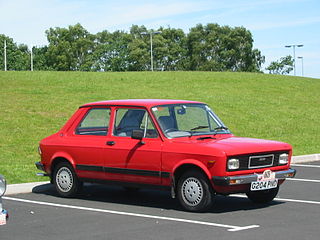
Zastava Skala, also known as Yugo Skala, is a generic name for a family of cars built by Yugoslavian manufacturer Zastava Automobili. Based on the Fiat 128 sedan, it was introduced in 1971 and sold as a 3 or 5-door liftback, a style that had not been issued or manufactured in Italy and was specifically trageted for the Balkan market, under the names Zastava 101, Zastava 1100, Zastava 1300,Zastava GTL, Yugo Skala 55c and Yugo Skala 65c.
1989 in motoring includes developments in the automotive industry throughout the year 1989 by various automobile manufacturers, grouped by country. The automotive industry designs, develops, manufactures, markets, and sells motor vehicles.

The Peugeot 208 is a supermini car produced by the French automaker Peugeot. Unveiled at the Geneva Motor Show in March 2012 and positioned below the larger 308. The 208 replaced the 207 in 2012, and the car is currently at its second generation.

The DS 4 is a compact car, and it is the second model in the luxury DS sub-brand created by Citroën, now an independent brand. Starting in 2021, it is currently in its second generation, which is based on an all-new EMP2 platform shared with the Opel Astra L and Peugeot 308 III.

The Rover R8 platform was an automobile platform used for the Mark I Rover 200 Series and the Mark II 200 and 400 Series, compact family cars produced by the Austin Rover Group, and later the Rover Group.

The Renault Symbol, Clio or Thalia in some markets, is a subcompact sedan produced by the French automobile manufacturer Renault. It was introduced in late 1999, under the Clio Symbol name, as the derivative version of the second generation Renault Clio, and unlike the hatchback it was marketed only in those countries where saloons were traditionally preferred over hatchbacks, while it was not sold in Western Europe. It was actually sold in France, but only in overseas departments/regions and collectivities.
France was a pioneer in the automotive industry and is the 11th-largest automobile manufacturer in the world by 2015 unit production and the third-largest in Europe. It had consistently been the 4th-largest from the end of World War II up to 2000. It is 16 % of sales of French manufactured products.
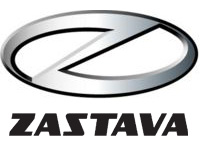
Zastava Automobiles was a Serbian international car manufacturer, a subsidiary of Group Zastava Vehicles which went bankrupt in May 2017.
Serbia's automotive industry is one of the most important industrial sectors and makes about 15% of industrial output of the country and 18% of all exports.
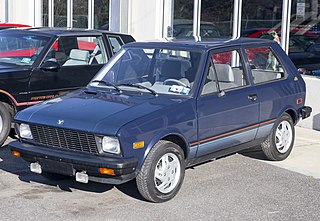
The Yugo, also marketed as the Zastava Koral, Yugo Koral, and Zastava Yugo is a subcompact hatchback formerly manufactured by Zastava Automobiles, at the time a Yugoslav corporation.
